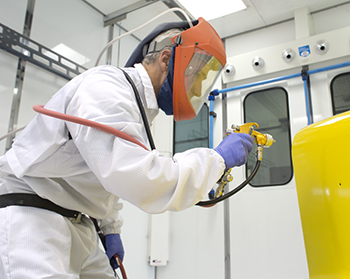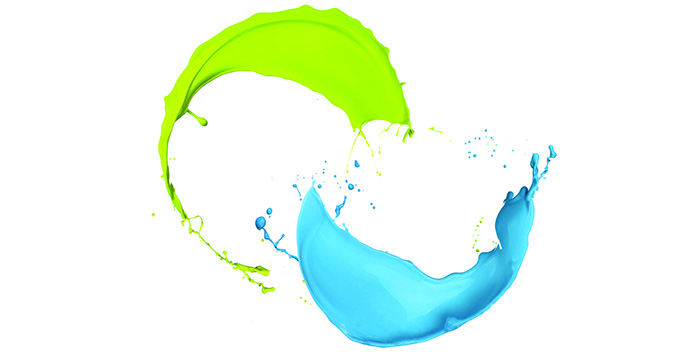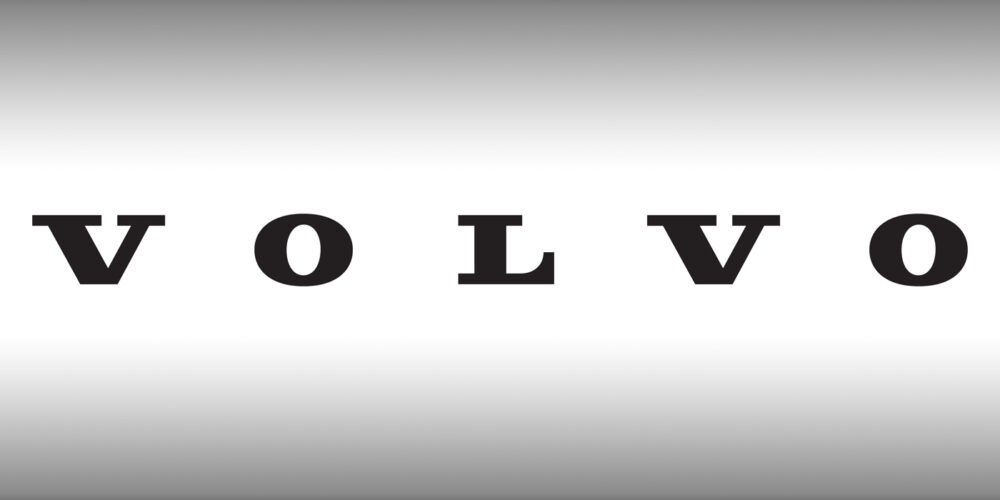Most fleets take great pride in the condition of their on-highway trucks, and why not? They are moving billboards that can reveal a lot about the fleet. A good-looking truck is a great on-the-road ambassador. Conversely, trucks with excessive signs of wear, like rust, fading paint finishes or nicks and dings, don’t leave a good impression.
According to Joe Krebs, director of marketing, Sherwin-Williams automotive finishes, “There are several things to consider when specifying paint finishes or having all or a portion of a fleet refinished. The first thing that comes to mind is durability. A fleet owner or manager needs to make sure that the proper paint products are chosen to match up with the desired physical property attributes. Standing up to things like corrosion, UV rays, certain chemicals, cleaning, etc. is important. Some fleet managers may choose products strictly on price, but in the end, will sacrifice durability and therefore end up spending more on a refinish in the future.”

Another consideration for any fleet manager or owner is branding and color. Krebs goes on to say that any truck in a fleet is a rolling advertisement for the business, typically seen by thousands of people. People tend to be drawn to newer, brighter, consistent branding and colors. The best fleets in the world usually look it, meaning they have the updated and consistent branding.
As for color choices, Krebs sees increasingly more effect finishes in the market place. Metallics, micas and custom paint jobs are becoming the norm. He notes, “People joke about Henry Ford offering any color you could want as long as it was black. Well, up until the last three to five years, many national fleets were the same way. You could choose any color you wanted as long as it was white or blue. That is starting to change. Many fleet managers and owners are using their own branding and colors and also offering choices to drivers as well. The key is to be consistent and have an updated look and feel. It will go a long way in promoting your company, brand and fleet.”
Life cycle & conditions
According to Christopher Papa, marketing manager, commercial coatings group Axalta Coating Systems, “Fleet owners should consider the desired life cycle and the environmental conditions that their assets will be exposed to. If the assets are expected to be part of the fleet for greater than five years or may be exposed to extreme conditions, a basecoat/clear coat system should be considered. A basecoat/clear coat system is designed to protect the asset with an enhanced degree of durability and gloss retention that should help lead to a longer life cycle of the asset in extreme weather conditions.
Aftermarket choices
Some of the things discussed above obviously apply to fleets purchasing in the aftermarket and doing their own painting. They also need to consider durability, branding, color, cost, downtime, etc. Krebs says, “My advice would be to partner with a good supplier. Many paint companies, like Sherwin-Williams, offer facility audits, consulting programs and training. These types of programs can be done on a national scale or even at the local level for smaller fleets. Whether the fleet is operating five vehicles or 5,000, there is no reason why it can’t be a world-class operation. From lean design consulting and inventory control to just-in-time delivery, the best suppliers will help a fleet achieve an efficient shop.”
Axalta offers a system that it references as “repair-in-kind,” meaning the same paint formulation used at the OEMs is available for use by repair facilities in the aftermarket, Papa notes. Repairing in-kind helps make it easier to match existing colors and helps make it possible to achieve an original factory finish that has staying power. “Asset uptime is extremely important in any industry,” he says. “Prompt repair of any damage with dependable product systems, including primer treatments, may allow a longer life cycle for the vehicle.”
Price of a gallon of paint?

For fleet managers, cost is always a consideration. Krebs notes that traditionally, people think of cost as “What is the price for a gallon of paint?” The selection goes way beyond cost. The most important piece of “cost” is minimizing downtime for the fleet of vehicles. If refinishing is a must, make sure to buy from a paint manufacturer that can offer all of the products needed when they’re needed.
For instance, says Krebs, “Sherwin-Williams has more than 200 automotive/fleet branches in North America that can supply primers, topcoats and clear coats, as well as any associated products like masking paper, tape, protective equipment, sandpaper, etc., all in one convenient location. We’ve established that consistent supply is important. It doesn’t mean anything unless the supply is of high quality products. Fleet owners and managers need to make sure they are buying highly productive coatings—paint systems that minimize downtime and provide the durability that was discussed above. For instance, the Genesis line of products offered by Sherwin-Williams Automotive Finishes, have direct-to-metal primers, fast drying topcoats and clear coats, some of which require no high temperature bake cycle. These kinds of products help fleet owners manage time and expense.”
He goes on to emphasize not to evaluate a paint manufacturer on the price of a gallon of paint. Be sure to do the proper investigation and determine whether they can help the shop become better over several facets of the business like the ones mentioned above. The final recommendation from Krebs is that fleet owners or managers should establish and stick to a regular maintenance routine for paint. The paint system should be considered a major component of any vehicle, just like the engine, the brakes or the tires. Finding and correcting issues early saves money in the long haul.
“Axalta Imron Elite premium quality polyurethane finishes, available in both single stage and basecoat/clear coat qualities, are designed for use on heavy-duty truck and transit vehicle OEM production lines, as well as in aftermarket repair and maintenance,” Papa says. “Axalta Excel Pro is recommended for repair and maintenance on heavy-duty truck and transit vehicles. Axalta Rival single stage polyurethane was recently introduced and designed to deliver just the right mix of price and value for the economy commercial transportation segment.”
Focus on primary needs
Paul Catanzarite, manager, commercial OEM and market development, PPG Commercial Coatings, states, “It’s important to focus on the fleet’s primary needs and concerns for a paint finish, particularly any shortcomings that may have been experienced with its present system such as corrosion or difficulty matching colors for spot repairs. For example, if color fading of a single-stage topcoat is a major concern, a recommended solution may be adding a clearcoat overlay or moving to a basecoat-clearcoat system. If corrosion has been a problem, it needs to be determined whether the root cause is galvanic, loss of adhesion, wear or chipping. Also, given the many different cost-benefit options for topcoat systems and corrosion protection products available, careful consideration must be given to the level of durability required in the context of the fleet’s operating environment and the length of warranty desired.”
Getting a handle on these top concerns will enable a paint supplier to recommend the most appropriate products.
“First and foremost, take advantage up front of any training provided by your paint supplier and work with them to address existing obstacles,” Catanzarite adds. “They can be a great partner in setting up your paint process and making improvements to achieve higher throughput, stronger back-end performance or leaner operations. PPG’s commercial field representatives, for example, are well-schooled in auditing the paint operation to determine the best fit and not only in terms of products; they can also advise on application equipment, workflow and other areas that have an impact on quality work and productivity. The audit forms the basis for a process chart that can be posted in the shop, detailing best practices and recommended procedures.”
New technology
The buzzwords in the industry are “speed,” “low VOC,” “waterborne” and “color.” Most paint manufacturers are developing new products around these mega-trends. It’s all about efficiencies and environmental impact.
“At this point, we haven’t seen many waterborne system introductions in the fleet refinish market, but it’s inevitable,” notes Krebs. “We’ve seen developments around water in several adjacent markets and it will ultimately make sense for fleet refinish as well.”
JJ Wirth, brand manager, fleet segment for PPG Commercial Coatings, says, “Recent advances in technology have enabled lower VOC products to perform equally well as their higher VOC predecessors. Reduction in emissions per unit can allow increased throughput for customers who may otherwise be bumping up against their emission limits.”
Additionally, faster curing products are working to increase productivity and primers that are more robust have been introduced that work easily is nearly any application facility. PPG’s newer epoxy primers for example can be applied over less-than-ideal substrates and still provide excellent corrosion and adhesion properties.
The most recent development within Sherwin-Williams, Krebs explains, is its high-process (HP) drying technology that was first introduced by Sherwin-Williams in its clear coats and primers about five years ago.
“From HPC15 Clear coat to P30 Speed Primer, these are best in class products offering unparalleled drying capabilities,” he says. “We leveraged that technology into our Genesis product line three years ago and came out with Genesis HP Premium Single Stage System. This topcoat dries in approximately 15 minutes at ambient temperatures with no baking required. This can save a fleet manager time and money and also lessen a shop’s carbon footprint. Another recent development is our Genesis LV Single Stage System—this topcoat system offers varying levels of gloss [flat, satin, semi-gloss, full gloss] at a low VOC level. As environmental regulations become stricter, manufacturers and shop owners are looking for this type of technology.”
 Key advice
Key advice
“There is a segment of this business that we haven’t addressed,” says Krebs. “The fleet owners or managers that are ‘subbing’ out their paint work. For these people, the same principles discussed above apply. But it’s probably more important to do more research. The fleet owner or manager shouldn’t necessarily use the shop with the lowest quoted price. Be sure that the shop is experienced with larger applications and fleet refinishing systems. There are many similarities between automotive vehicle refinish and fleet refinish, but there are also subtle differences, too. Making the wrong choice can end up costing time and money beyond the initial expectation.”
Axalta’s Papa agrees, “We believe the overall fleet color and finish quality can affect a company’s reputation. A fleet with unmaintained finishes may negatively impact its company’s position in the marketplace and its reputation among existing customers. This could make it difficult to win potential customers. “Color choice is very important in promoting a fleet’s brand image, Papa continues. Axalta has crafted an extensive offering of innovative electronic and traditional color tools designed to help make selecting the right color or matching an existing one, fast and simple. Every year, Axalta works to develop thousands of new colors to deliver even more options.
Axalta recommends the following general preventative maintenance to help keep fleet assets looking pristine:
- Proper cleaning on a regular basis; a daily rinse is encouraged.
- Utilizing a proper PH cleaning solution followed by an appropriate rinse.
- Adequately rinse acid-based cleaning products from the surface.
- Promptly rinse mud or debris from the vehicle, including the undercarriage and wheel wells.
Final word
Catanzarite encourages fleets to stay current: “Make a commitment to see that your paint technicians keep abreast with the latest products and application procedures, and take advantage of available training courses from your paint manufacturer and distributor. Every two years, for example, participants in PPG’s technician certification program are required to attend a two-day training course at one of its regional training centers.”














